
Nature's paradise
Lassana Sri Lanka's Knuckle's Range:
by Rosanne Koelmeyer Anderson
The Knuckles Range embedded in the rocky cliffs, named after the five
peaks, Kirigalpottha 1642m (5403 ft), Gombaniya 1893m (6248) Knuckles
1852m (6122) Koboneelagala 1544m (5198) and Dotulugala 1564m (5161) look
like the knuckles of a clenched fist.
A name given by the British in the 19th century, known by the
villagers of yore as the 'Dumbara' Range, meaning 'misty mountains',
Knuckles may carry a story of history dating back to the era of King
Ravana.
|
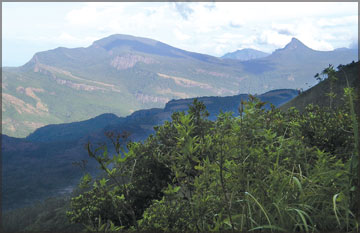
Knuckles Panorama Pix by Mahendra Siriwardhane |
Knuckles is a landscape found nowhere else in Sri Lanka, a tropical
parallel referred to as the 'Mini Alps' by scientist for its formation
of a series of peaks and penny plains almost 6250 ft above sea level
adding to the magnificent beauty and high bio diversity of Lassana Sri
Lanka.
Located in the intermediate climatic zone of Central Sri Lanka,
Knuckles range experiences a wide spectrum of rainfall and temperature
differences as well the exposure to strong wind which has given Knuckles
an array of natural vegetation and a rich composition of animals and
plants which has attracted many a nature lover and researcher to its
precincts.
Knuckles, according to environmentalists represents all features of
the main climatic zones, not found in any other mountain range in the
country. Scientists and environmentalists also regard this 1,829 square
kilometers of lush green virgin as one of the world's most unique
ecosystems.
Knuckles is also the main water source of the Mahaweli, the main
water source of the island's hydropower and irrigated agriculture in the
dry zone, with many tributaries including Hulu Ganga, Heen Ganga and
Kalu Ganga springing from the Range.
|
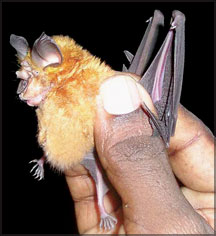
Rufous Horse shoe Bat |
Moreover, the Knuckles Forest Range is a cradle for plant and animal
life and is an invaluable asset where biodiversity and watershed values
are concerned.
"With gigantic trees, vast shrub areas and a colourful array of bird
and animal life, the Knuckles Range provides a microcosm of the entire
variety of climatic conditions in the country, from extreme wet to
nearly arid," notes a study in 1994, by Worldview-NORAD titled 'Gift of
Nature to Sri Lanka'.
Of many fauna and flora found in region, the Range constitutes about
50 per cent of tree, 25 per cent of flowering plants, 20 per cent of
ferns and 50 per cent of reptiles and amphibians endemic to the island.
It is interesting to note that "A total of 1033 flowering plants
belonging to 141 families have been recorded from the above vegetation
types in Knuckles. Of the total number of flowering plant species
documented in Knuckles, 160 (15 per cent) are endemic to Sri Lanka,
while about 3 per cent are nationally threatened," according to World
Conservation Union (IUCN) studies on Knuckes.
Mahendra Siriwardhane an environmentalist and bird expert and former
coordinator of the Enviornment Education Unit of the Open University
Nawala in an interview and presentation 'A random visit to nature' said
the misty mountains also provide a habitat for a variety of species not
found elsewhere in the world and many endangered species.
|
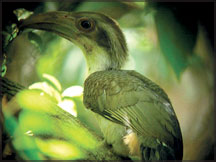
Grey Hornbill |
"Similarly, Knuckles holds a great variety of fauna. Most important
is that it is home to many endangered and endemic species.
About 230 vertebrate species have been recorded from this area of
which 20 per cent are endemic to Sri Lanka, including 14 bird and nine
fish species. Five of these endemic species, three freshwater fish
(Phillip's gara - Garra phillipsi, Martenstyne's barb - Puntius
martenstyni, Blotchedfilamented barb - Puntius srilankensis) one
amphibian (Marbled cliff frog - Nannophrys marmorata) and one lizard (Tennent's
horned lizard - Ceretophora tennenti) are restricted to the Knuckles
Forest Range while 25 per cent of the vertebrates found in the Knuckles
range are nationally threatened.
In addition a large number of species of reptiles, spiders,
butterflies (over 70 species) and other insects have been recorded too
in the Knuckles Range".
|
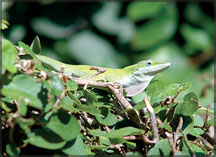
Green Garden Lizard |
"The poisonous snakes like the slow moving nightly Green Viper, the
Pit Viper with its third eye, the Cobra and the Russel's Viper are
commonly seen in the Knuckles Range.
Amazingly, Mahendra explained that in 1998 Sri Lanka got a Genius
record for the maximum number of deaths in the Anuradhapura district as
a result of being stung by the Russell's Viper, the most dangerous snake
species.
The Hump-nosed viper he explained is a fast attacker and can detect
heat well belongs to an undescribed species probably new and found
everywhere except in Nuwara Eliya. The Army of Ants of Sri Lanka found
in the Knuckles is dangerous to. It can spread in a second and attack
people", he explained.
|

Flying Fox |
"The commonest Lizard, the Brown Garden Lizard and the Green Garden
Lizard which has a very good colouration which indicates that its
healthy are interesting to observer while the Rose-ringed Parakeet, the
most common next to the crow but very aggressive and the commonest frogs
in the rainforest, ranatemperatis could also be seen at Knuckles.
The communal nesting place of the Golden Gecko and the most clever
bat species in Sri Lanka, the Great Forest Gecko, the largest in Sri
Lanka about 9' long which lives in the rock caves in wet forests and the
Golden Horse Shoe Bat could also be spotted here.
Interestingly, the largest of the species, the Flying Fox, a fruit
eater which lives on trees exposed to the sunlight could be observed.
Another interesting phenomenon similar among Pelicans and Spoonbills is
flocking.
|
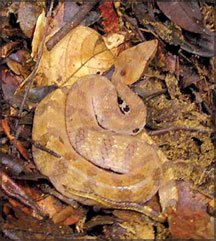
Hump-nosed viper |
The Grey Houndbill which has a very special way of nestling and the
Sri Lankan jungle fowl are endemics", he further explained.
An area which provides all types of climatic features, the Knuckles
Range has naturally become the habitat of many bird varieties, including
migrant birds. Over 40 varieties of birds and butterflies are also found
there. Of the identified 21 endemic bird varieties, 14 are found only in
that area. Of the 28 endangered species, nine are found here with three
species being only found in the Knuckles.
Vicious varieties of spiders and other insects are also found here,
though a proper survey on this subject has never been conducted. Some of
the most rare herbal plants like Iruraja, Maharaja, kohomba, Maha hedaya
and Pihimbiya and many others also grow here. Several valuable trees
like Mahogany, Teak and Milla could also be found here.
According to forest range officers, rain is a permanent feature and
owing to its setting, the area also experiences the highest rainfall in
the central hills. Although it is cold up in the Knuckles you would even
find Binara, a pleasing sight of a purple flower growing amidst natures
wondrous landscape, a land with beauty beyond compare.
[email protected]
|
